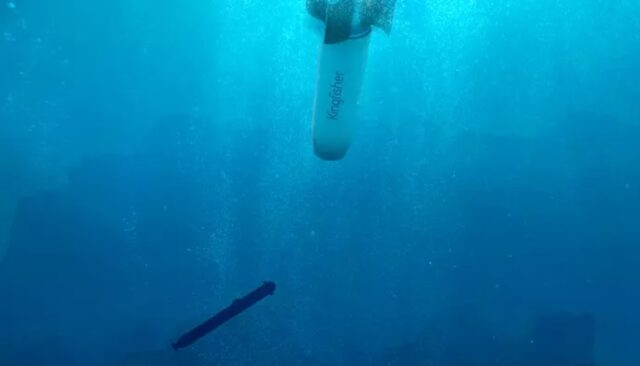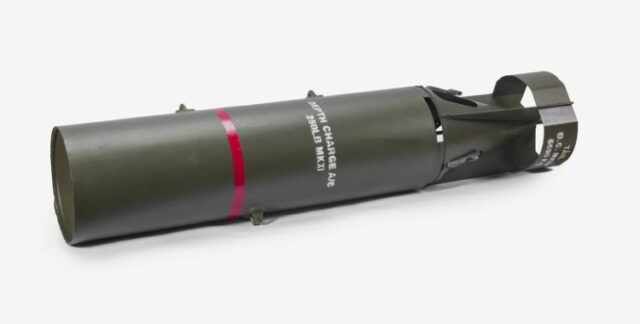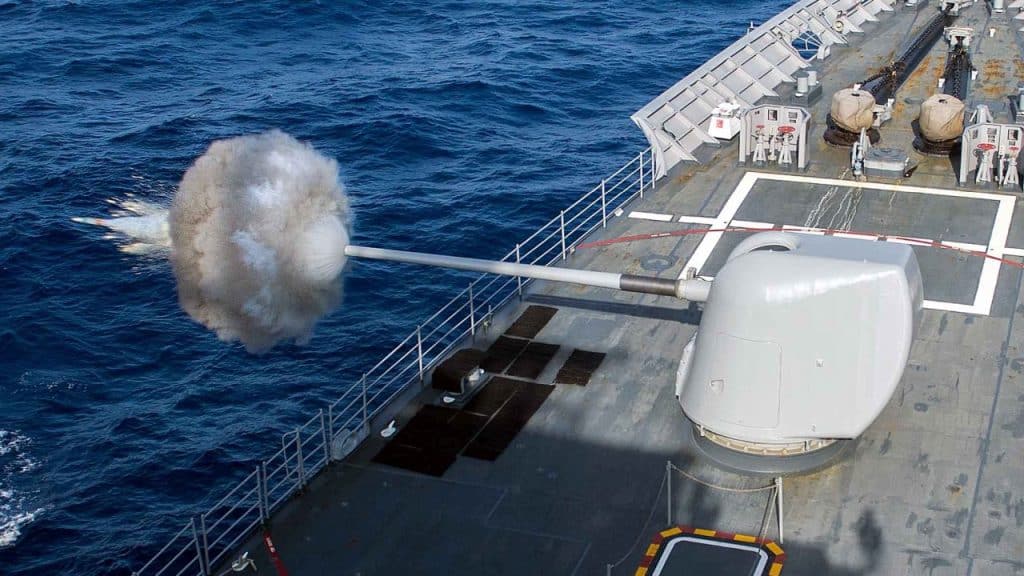The British arms concern BAE Systems has been developing an innovative solution to combat underwater targets since 2018. It is a Kingfisher artillery cartridge, which in practice is a 127-millimeter cartridge fired from a ship’s cannon. The container may contain a small depth bomb, but also a sonar buoy, a miniature unmanned vehicle, hydroacoustic lures or hydrographic sensors. The Kingfisher can be fired from standard 127mm naval guns. The manufacturer has in mind the Mk 45 gun, which he produces himself.
Kingfisher is to be a low-cost method of countering underwater targets, especially the rapidly growing group of unmanned underwater vehicles. Its development is financed by the concern’s own resources, with little help from the Defense Science and Technology Laboratory and the Royal Navy.
Work on the Kingfisher began as it was judged that the currently armed Mk 11 depth charge, which basically dates back to World War I, needs to be replaced. The body of the depth charge Mk 11 Mod 3 is four millimeters thick, the nose is formed in such a way as to withstand the entry into the water at high speed, and ballasts are installed in the rear part.
The Mk 11 is dropped from helicopters, but only in strictly defined tactical situations – when the submarine is detected in very shallow water or at periscope depth. These are conditions under which advanced anti-submarine torpedoes do not perform well. In addition, expensive torpedoes are not the optimal weapon against unmanned submersible vehicles or underwater vehicles for transporting divers.

Artistic vision of the Kingfisher depth bomb.
(BAE Systems)
The concept of an artillery cartridge as a container is nothing new. For decades, in land artillery, cartridges have been used that are de facto containers for cluster munitions, light flares, smoke generators and even leaflets. Therefore, BAE Systems is not tied to the marine caliber of 127 millimeters, and further development may also depend on the demand from the land forces, as it is possible to create cartridges of this type of caliber 155 millimeters.
On the other hand, as part of the modernization of the artillery and the selection of the successor to the 105mm L118 light howitzers, the British Army is considering ordering new 127mm howitzers. Such a howitzer will be less mobile, but it will allow the ammunition to be unified with the navy.
The cartridge is equipped with a programmable igniter. At the time of launch, the target’s position is known, so when the cartridge is at a given point, a small explosive pushes the depth charge out of the cartridge. Then, the ballasts responsible for maintaining the right angle of entry into the water are folded into the bomb. Once the bomb is in the water, it descends to a programmed depth and detonates a three-kilogram warhead.
Although the mass of the warhead is small, it should be enough to destroy underwater special forces vehicles, underwater unmanned vehicles or even attacking torpedoes. Unlike other types of weapons, it takes a few seconds to fire a cannon shell based on even a weak sonar signal, and it takes a little longer to reach a target located up to thirty kilometers from the ship.
As a rule, not one round is fired, but many, increasing the probability of a hit. The rate of fire of the Mk 45 gun is up to twenty rounds per minute. In the case of large submarines, for which a three-kilogram warhead does not pose a serious threat, such unexpected fire will put the commander of the submarine in a defensive situation, disrupt the operation of his sonars and give the surface ships time to take further action.

Mk 11 depth bomb in the version used during the Second World War.
(© IWM)
In addition, Kingfisher can be an additional rung on the escalation ladder in a crisis. In the event of contact between two surface ships, commanders have at their disposal radio communication, fire control radar illumination, performing certain aggressive maneuvers or firing a shot forward. Many of these options are unavailable when a surface ship and a submarine come into contact. You can send active sonar pings several times, but then you reveal your position and lose your tactical advantage.
The use of Kingfisher with a small explosive charge can act as a deterrent to a submarine without causing harm to it. We witnessed such use of practice depth bombs during the Cuban crisis, when the Americans threw them at Soviet submarines.
In the case of combating unmanned underwater vehicles of various sizes, the main advantage of the Kingfisher is the price. Advanced systems for combating such targets are already included in armaments, but often the high price does not justify the use of these measures against very simple and cheap threats. This situation is analogous to shooting down primitive drones with advanced anti-aircraft systems. You can, but it is a waste of valuable resources that should be dedicated to fighting key threats.
In this case, even if the Kingfisher does not hit directly, due to the generally light construction of unmanned vehicles, there is a high chance of destroying or damaging the target with a shockwave. The same applies to underwater vehicles for transporting special forces soldiers and the divers themselves.
An important potential use is to defend against attacking torpedoes. In such tasks, the Kingfisher can be deployed at a much greater distance from the ship than traditional lures or mini-torpedoes, providing an additional, most advanced layer of protection. Bursts of several rounds in the vicinity of the torpedo, even if they do not destroy it, may damage or disrupt the sonar operation or cut the fiber-optic cable connecting the torpedo with the submarine.
As mentioned in the Kingfisher cartridge holder, other things can also be carried, such as sonar buoys, unmanned vehicles and communication devices. These are just ideas for now, as developing them will be complicated. Firstly, because they must be small (the container is 400 millimeters long and 85 millimeters in diameter), and second, because all equipment must be constructed in such a way as to withstand the enormous overloads generated when fired. Acceleration can be up to several thousand g.
If these difficulties are overcome, ship commanders will have many new opportunities. Sonar buoys fired at a distance of thirty kilometers may cooperate with helicopters or be launched in one direction while the helicopter is in surveillance of another sector. If there is a need for visual identification, launching a small drone in an artillery cartridge will allow you to get an image after a few minutes – much faster than a traditional drone flight to a given place.
Another option is to place hydrographic sensors in the reservoir that measure changes in temperature and salinity along with the sinking of the sensor. After reaching the target depth, the container would emerge and transmit the acquired data to the ship, so that the sonar parameters could be better adapted to local conditions. Finally, a floating relay station could be placed in the container to extend the range of unmanned submarines or to communicate with submerged submarines.
See also: Ideas for asymmetric warfare: Return of privateering
US Navy / Mass Communication Specialist 2nd Class Ryan J. Batchelder

